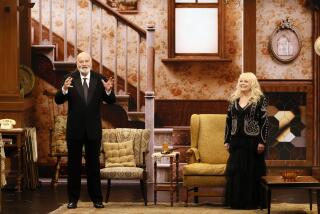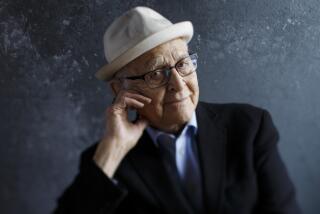A Few Think Him Pleasant Enough : There once was a writer named Lear, whose fondness for children was clear : EDWARD LEAR: A Biography, <i> By Peter Levi (Scribner: $30; 362 pp.)</i>
- Share via
Charmingly declaring the Victorian nonsense poet Edward Lear to be “one of the world’s natural uncles,” his newest biographer, the British poet and classicist Peter Levi, seems to be vying for the position of favorite nephew.
That he finds Lear’s limericks, comic drawings and such poems as “The Owl and the Pussycat” sublime does not distinguish him from the many children for whom Lear wrote and drew, and the legions ever after who have worn out their first copies of Lear books in the nursery. Nor is Levi alone in voicing appreciation for Lear’s serious art, which is coming back into favor after decades of oblivion.
But this widespread adulation is only Levi’s starting point. He goes on to maintain that Lear’s youthful drawing of a leopard is superior to Blake’s “Tyger,” his bird drawings compare favorably with Audubon’s, his landscapes are in a class with Turner’s, his poetry is as original as Tennyson’s and his wit is as fine as Jane Austen’s.
As if to chastise the impertinent, Levi severely rejects previous biographers’ hints that Lear might have been homosexual, brushes aside a suspicious-sounding childhood trauma although it left Lear with a lifelong complaint against a cousin who “did the greatest evil done to me in life,” and confesses himself bewildered that a lady 46 years younger than Lear should decline his offer of marriage.
He also takes swats at those he thinks got an unfair share of uncle’s attention. Lear’s evaluation of Hubert Congreve, a second-generation friend: “A youth to whom I am much attached, and whom I respect also.” Levi’s comment: “I am uncertain whether Hubert was a booby, or only grew up into a booby later.”
The result is more of a fondly proprietary ramble through Lear’s legacy than a biography. Levi permits himself to plead absent-mindedness on small points, rather than check the library. Some startling people pass blandly through, unflagged for the reader other than as Lear saw them--the carefree little daughters of J.A. Symonds, one of whom grew up to be the model for Virginia Woolf’s “Mrs. Dalloway”; Mrs. J.E. Millais, whom Lear deems cold and vulgar without noting that she had been the bubbly belle of Venice, left notoriously untouched by her first husband, John Ruskin.
But this eccentric refusal to play the modern biographer oddly captures the Victorian spirit that Lear personifies. Having mostly succeeded in keeping his trouble secret--Lear had enough warning of his epileptic seizures to “melt away” from company--he is allowed the dignity of being defined through his work and friendships, rather than personal moods and sorrows.
Today, when bachelor uncles who are unusually fond of children are more likely to attract suspicion than admiration, it is common to assume that the hidden self is truer than the purposefully presented one. A man whose diaries reveal a soupcon of depression runs the risk of being reduced to a checklist of problems.
But although Edward Lear had his share of loneliness, moodiness and fussiness, his joys shine through. He trained his wonderful imagination on the outside world--its amazing birds, bugs, furry animals and plants, and the beauties, strangeness and odd discomforts of foreign societies. Lear toddled (Levi’s well-chosen word) around the world, being pursued by rabid swans, mistaking a pig for a chair, being assigned to share his hotel room with a mad dervish, waving a fried whiting about to celebrate a friend’s promotion, and being awakened by strange noises that turn out to come from “a very big, very dirty sheep under his bed.”
Others who have adopted him as a favorite uncle will be relieved. Whatever can be found about him, it turns out that Lear really was Lear.
More to Read
Sign up for our Book Club newsletter
Get the latest news, events and more from the Los Angeles Times Book Club, and help us get L.A. reading and talking.
You may occasionally receive promotional content from the Los Angeles Times.









